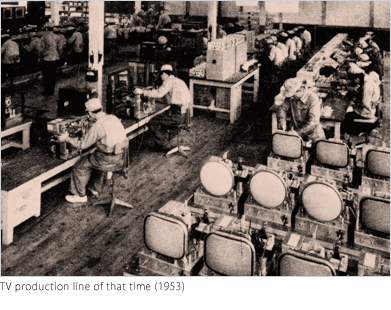1951 - 1953
Twenty Years after Predicting the Age of Television, Achieving a Long-Cherished Wish
The year 1926 was still not long into the Showa Era, and in Japan, the first television experiment would be successful at the Hamamatsu School of Technology (today, Shizuoka University). Tokuji, who learned of it a few years later when it was announced, predicted that the television age was sure to follow the radio age. He began research on television by getting in touch with the school and bringing the favorite pupil of the researcher into the company. At that time, Tokuji’s radio business was just getting off the ground. However, he was already thinking of his next move. In the ensuing years, his enthusiasm for television never let up, but during and immediately after the war, development came to a standstill as a result of official orders restricting research, and it was not until 1951, after the passage of more than 20 years, that the company completed a practical prototype. The following year, Tokuji traveled to the United States to seek a technology tie-up with RCA (Radio Corporation of America) and obtain the use of their patents. After returning to Japan, he immediately pressed forward to bring a practical product to market, ultimately introducing Japan’s first domestically manufactured television and boldly plunging into mass production.


